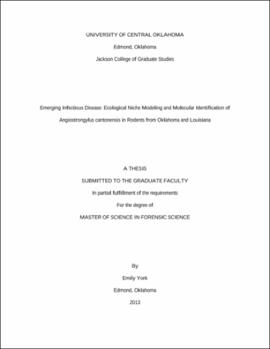| dc.contributor.advisor | Lord, Wayne | |
| dc.contributor.author | York, Emily | |
| dc.date.accessioned | 2020-05-26T21:07:58Z | |
| dc.date.available | 2020-05-26T21:07:58Z | |
| dc.date.issued | 2013 | |
| dc.identifier.other | (AlmaMMSId)9980690085202196 | |
| dc.identifier.uri | https://hdl.handle.net/11244/324799 | |
| dc.description.abstract | Emerging infectious diseases (EIDs) have devastating effects on wildlife. Angiostrongylus cantonensis is a zoonotic EID that causes eosinophilic meningitis in humans and neurological illnesses in wildlife. Because A. cantonensis has been documented worldwide and continues to spread, it is a clear example of an EID of potential pathogenicity to both humans and wildlife. The advent of modeling techniques to predict the geographic distribution of pathogens, in conjunction with modern molecular genetics, provides a unique opportunity to gain insight into the distribution of A. cantonensis, and evaluate methods of disease surveillance. I used the modeling program Maxent in combination with IPCC bioclimatic variables to build an ENM to predict current and future distributions of A. cantonensis. I tested these predictions by sampling rodents in SE Oklahoma and Louisiana and analyzing tissues for the parasite using qPCR. Out of 34 samples identified as positive, sequencing analysis revealed only three definitive identifications, one from Sigmodon hispidus and two from Rattus norvegicus. The remaining 31 samples were classified as "false positives" by qPCR. Sequences from positive samples were compared to those on GenBank through BLAST with a match to A. cantonensis. Phylogenetic analysis confirmed relationships by comparing positive sample sequences to A. cantonensis and two closely related species, Angiostrongylus vasorum and Angiostrongylus costaricensis. All phylogenetic methods grouped positive samples and A. cantonensis with 100% confidence. The projected future distribution for A. cantonensis indicates an overall decrease in suitable habitat and a range shift. The findings from this study alter our current perspective of A. cantonensis within the United States, and demonstrate the successful application of two important epidemiological techniques that may be applied more broadly to a variety of EIDs. | |
| dc.rights | All rights reserved by the author, who has granted UCO Chambers Library the non-exclusive right to share this material in its online repositories. Contact UCO Chambers Library's Digital Initiatives Working Group at diwg@uco.edu for the permission policy on the use, reproduction or distribution of this material. | |
| dc.subject.lcsh | Communicable diseases | |
| dc.subject.lcsh | Communicable diseases | |
| dc.subject.lcsh | Meningitis | |
| dc.subject.lcsh | Molecular biology | |
| dc.subject.lcsh | Molecular genetics | |
| dc.subject.lcsh | Niche (Ecology) | |
| dc.subject.lcsh | Public health surveillance | |
| dc.subject.lcsh | Zoonoses | |
| dc.title | Emerging infectious disease : ecological niche modeling and molecular identification of Angiostrongylus cantonensis in rodents from Oklahoma and Louisiana. | |
| dc.type | Academic theses | |
| dc.contributor.committeeMember | Caire, William | |
| dc.contributor.committeeMember | Creecy, James | |
| dc.thesis.degree | M.S., Forensic Science | |
| dc.identifier.oclc | (OCoLC)ocn884965939 | |
| uco.group | UCO - Graduate Works and Theses::UCO - Theses | |
| thesis.degree.grantor | Jackson College of Graduate Studies | |
